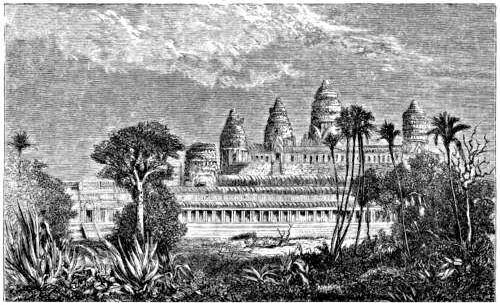Henri Mouhot´s Travels in Siam, Cambodia and Laos, 1858-1860
by Charles Mouhot & Henri Mouhot
First edition of Henri Mouhot's famous relation on his journeys through Indochina.

- Publication
- John Murray Publisher, London. This is the Gutenberg Project version, released August 11, 2014 [EBook #46559]
- Published
- 1863
- Authors
- Charles Mouhot & Henri Mouhot
- Pages
- 280
- Language
- English
This edition, established in English by Henri Mouhot’s brother, Charles, includes engravings and lithographs created from the explorer’s sketches and photographs.
“Half English by his marriage, M. Mouhot still preserved his love for his own country (France, Editor’s note): there, however, for various reasons he did not receive the encouragement he anticipated, and it was on the hospitable soil of England that he met with that aid and support, which not only her scientific men, but the whole nation, delight in affording to explorations in unknown countries, ever attended by perils and hardships”, notes Charles Mouhot in his foreword, adding: “The journal of the unfortunate traveller shows his feelings of affection for the two countries which he loved equally, and his devotion to science, art, and the progress of civilization.”


Two drawings by M. Guiaud from Henri Mouhot’s sketches and photographs.

An actress near Angkor, drawing by M. Bocourt.
Tags: 19th century, French explorers, travelogue, Angkor rediscovery
About the Authors

Charles Mouhot
Charles Mouhot (1828 — 1904) was a younger brother of Henri Alexandre Mouhot, the famous French explorer who gave a vivid description of Angkor in 1859.
Just a year after Henri’s death in Laos in 1861, Charles Mouhot completed the English translation of his brother’s travelogue, Travels in the Central Parts of Indo-china (Siam), Cambodia and Laos, based on Henri’s personal notes and his letters to Charles as well as to Henri’s wife, Anne (Annette) Mouhot née Park. Dedicated to “the learned Societies of England”, this edition carried a presentation(“Memoir of Henri Mouhot”) by J.J. Belinfante.
Charles Mouhot’s own wife, Jane Elizabeth Mary (Jenny) Mouhot née Park (1831, London — ?), was a cousin of Annette, and both were related to illustrious Scottish explorer Mungo Park, a celebrated explorer of Western Africa.

Henri Mouhot
Philologist, self-taught photographer and naturalist Henri Alexandre Mouhot (15 May 1826, Montbeliard, France ‑10 Nov. 1861, Naphan, Laos) started exploring South East Asia in 1857 with the support of the Royal Geographical Society and the Zoological Society of London. French authorities never supported his journeys aimed at natural sciences research.
Mouhot´s connection with Great Britain was also personal since he married in 1856 the granddaughter (or niece?) of famous Scottish explorer Mungo Park (1771−1806), Annette Park (18??, Berwick-on-Tweed — 1894), and lived with her in Jersey. His brother Charles, who traveled with him across Europe and Russia, married another of Park´s relative, Jane Elizabeth Mary Park.
Also, it has been said that John Bowring´s book published in 1857, The Kingdom and People of Siam, gave him the idea of visiting South East India. Last but not least, his travelogue around South East Asia was first published in London in an edition collated by Charles Mouhot in 1862.
His Journal and letters, later collated in the book Voyage dans les Royaumes de Siam, de Cambodge et de Laos (1868) for the French public, became a sensation for his description of Angkor, which he reached from the South in January 1860 (chapters 18, 19, 20). If he was not the first Westerner to access the Angkorian site, his relation was so vivid, detailed and well-written that ït gave him (posthumously) the reputation of being the first “Angkor rediscoverer”. [in 1874, Hachette Publishers included Mouhot’s book in its popular “Pink Library”, 3d series (“For teenagers, possibly in a library for young girls aged 14 to 18 years).]
Henri Mouhot, was had studied Greek and Latin and taught Greek at a Saint-Petersburg gymnasium during the twelve years he stayed in Russia, took some epigraphic notes on Khmer and Lao languages that are kept at the British Library (collection Or.4736) and can be viewed here. They are parts of Mouhot’s documents and notes which were brought to London by Dr. James Campbell and given to his widow, Anne Mouhot. She gave these papers to the British Museum in 1894, over 30 years after her husband’s death, and the originally loose-leaf papers (most of them dated 1860 and 1861) were recently bound together in book form by the British Museum.
Henri Mouhot died of malaria fever (called “fievre des bois” among the French explorers of Indochina) on Nov 10, 1861, in the vicinity of Luang Prabang, the southernmost Royal city of Laos. His grave, erected in 1867, has been rediscovered in 1989.
According to American Protestant missionary Daniel McGilvary, who visited the area in 1876 – 1877 (in A Half Century Among the Siamese and The Lao, An Autobiography, Fleming H. Revell Company, New York, 1912), “no doubt the real spirits are the malarial germs or the poisonous gas which later we found to be the chief danger of the Chieng Dāo cave. It was in this cave that M. Mouhot, a noted French scientist, contracted the fever from which he died. The natives believed that his death was caused by his rashness in trespassing upon the domain of the spirits who preside over the cave.”
As a naturalist in Laos, Mouhot is credited of numerous discoveries of numerous specimens of insects and shells that were not previously known to Western zoologists, including an impressive black beetle that was later named Mouhotia gloriosa, and an extraordinarily shaped spider now known as Cyphagogus Mouhotii.




